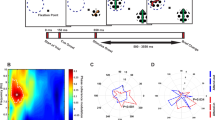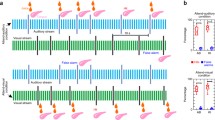Abstract
Analysing a visual scene requires the brain to briefly keep in memory potentially relevant items of that scene and then direct attention to their locations for detailed processing. To reveal the neuronal basis of the underlying working memory and top-down attention processes, we trained macaques to match two patterns presented with a delay between them. As the above processes are likely to require communication between brain regions, and the parietal cortex is known to be involved in spatial attention, we simultaneously recorded neuronal activities from the interconnected parietal and middle temporal areas. We found that mnemonic information about features of the first pattern was retained in coherent oscillating activity between the two areas in high-frequency bands, followed by coherent activity in lower frequency bands mediating top-down attention on the relevant spatial location. Oscillations maintaining featural information also modulated activity of the cells of the parietal cortex that mediate attention. This could potentially enable transfer of information to organize top-down signals necessary for selective attention. Our results provide evidence in support of a two-stage model of visual attention where the first stage involves creating a saliency map representing a visual scene and at the second stage attentional feedback is provided to cortical areas involved in detailed analysis of the attended parts of a scene.






Similar content being viewed by others
Data availability
All data that are not presented in manuscript are available from the corresponding author upon reasonable request.
References
Baizer JS, Ungerleider LG, Desimone R (1991) Organization of visual inputs to the inferior temporal and posterior parietal cortex in macaques. J Neurosci 11(1):168–190
Bisley JW, Goldberg ME (2010) Attention, intention, and priority in the parietal lobe. Annu Rev Neurosci 33:1–21
Bokil H, Purpura K, Schoffelen J-M, Tomson D, Mitra P (2007) Comparing spectra and coherences for groups of unequal size. J Neurosci Methods 159:337–345
Bullier J (2001) Integrated model of visual processing. Brain Res Rev 36:96–107
Buschman TJ, Miller EK (2007) Top-down versus bottom-up control of attention in the prefrontal and posterior parietal cortices. Science 315:1860–1962
Buzsáki G (2006) Rhythms in the brain. Oxford University Press
Buzsáki G, Draguhn A (2004) Neuronal oscillations in cortical networks. Science 304:1926–1929
Buzsáki G, Logothetis N, Singer W (2013) Scaling brain size, keeping timing: evolutionary preservation of brain rhythms. Neuron 80:751–764
Fries P (2005) A mechanism for cognitive dynamics: neuronal communication through neuronal coherence. Trends Cogn Sci 9:474–480
Funahashi S, Bruce CJ, Goldman-Rakic PS (1989) Mnemonic coding of visual space in the monkey’s dorsolateral prefrontal cortex. J Neurophysiol 61:331–349
Gregoriou GG, Gotts SJ, Zhou H, Desimone R (2009) Long-range neural coupling through synchronization with attention. Science 176:35–45
Hawellek DJ, Wong YT, Pesaran B (2016) Temporal coding of reward-guided choice in the posterior parietal cortex. Proc Nat Acad Sci 113:13492–13497
Herrington TM, Assad JA (2010) Temporal sequence of attentional modulation in the lateral intraparietal area and middle temporal area during rapid covert shifts of ateetntion. J Neurosci 30(9):3287–3296
Hutcheon B, Yarom Y (2000) Resonance, oscillation and the intrinsic frequency preferences of neurons. Trends Neurosci 23:216–222
Ibos G, Freedman DJ (2016) Interaction between spatial and feature attention in posterior parietal cortex. Neuron 91:931–943
Jarvis MR, Mitra PP (2001) Sampling properties of the spectrum and coherency of sequences of action potentials. Neural Comput 13:717–749
Khamechian MB, Kozyrev V, Treue S, Esghaei M, Daliri MR (2019) Routing information flow by separate neural synchrony frequencies allows for “functionally labeled lines” in higher primate cortex. Proc Natl Acad Sci USA 116:12506–12515
Kusunoki M, Gottlieb J, Goldberg ME (2000) The lateral intraparietal area as a salience map: the representation of abrupt onset, stimulus motion, and task relevance. Vision Res 40:1459–1468
Lee H, Simpson GV, Logothetis NK, Rainer G (2005) Phase locking of single neuron activity to theta oscillations during working memory in monkey extrastriate visual cortex. Neuron 45:147–156
Levichkina E, Saalmann YB, Vidyasagar TR (2017) Coding of spatial attention priorities and object features in the macaque lateral intraparietal cortex. Physiol Rep 5:e13136
Liebe S, Hoerzer GM, Logothetis NK, Rainer G (2012) Theta coupling between V4 and prefrontal cortex predicts visual short-term memory performance. Nat Neurosci 15:456–462
Luczak A, McNaughton BL, Harris KD (2016) Packet-based communication in the cortex. Ann Rev Neurosci 16:745–755
Maloney RT, Jayakumar J, Levichkina E, Pigarev IN, Vidyasagar TR (2013) Information processing bottlenecks in macaque posterior parietal cortex: an attentional blink? Exp Brain Res 288:365–376
Mendoza-Halliday D, Torres S, Martinez-Trujillo JC (2014) Sharp emergence of feature-selective sustained activity along the dorsal visual pathway. Nat Neurosci 17:1255–1262
Mitra PP, Bokil H (2008) Observed brain dynamics. Oxford University Press
Mitra PP, Pesaran B (1999) Analysis of dynamic brain imaging data. Biophys J 76:691–708
Nikolaev AR, van Leeuwen C (2019) Scene buildup from latent memory representations across eye movements. Front Psychol 9:2701
Noguchi Y, Kakagi R (2020) Temporal codes of visual working memory in the human cerebral cortex brain rhythms assovciated with high memory capacity. Neuroimage 222:117294
Ogawa T, Komatsu H (2009) Condition-dependent and condition-independent target selection in the macaque posterior parietal cortex. J Neurophysiol 101:721–736
Payne L, Kounios J (2009) Coherent oscillatory networks sustain short-term memory retention. Brain Res 1247:126–132
Pesaran B (2010) Neural correlations, decisions, and actions. Curr Opin Neurobiol 20:166–171
Pigarev IN, Nothdurft HC, Kastner S (1997) A reversible system for chronic recordings in macaque monkeys. J Neurosci Methods 77:157–162
Pigarev IN, Saalmann YB, Vidyasagar TR (2009) A minimally invasive and reversible system for chronic recordings from multiple brain sites in macaque monkeys. J Neurosci Methods 181:151–158
Quiroga RQ, Nadasdy Z, Ben-Shaul Y (2004) Unsupervised spike detection and sorting with wavelets and superparamagnetic clustering. Neural Comput 16:1661–1687
Ray S, Maunsell JHR (2011) Network rhythms influence the relationship between spike-triggered local field potential and functional connectivity. J Neurosci 31:12674–121685
Saalmann YB, Pigarev IN, Vidyasagar TR (2007) Neural mechanisms of visual attention: how top-down feedback highlights relevant locations. Science 316:1612–1615
Scheffer-Teixeira R, Belchior H, Leao RN, Ribeiro S, Tort ABL (2013) On high-frequency field oscillations (>100Hz) and the spectral leakage of spiking activity. J Neurosci 33:1535–1539
Sereno AB, Maunsell JHR (1998) Shape selectivity in primate lateral intraparietal cortex. Nature 395:500–503
Singer W (1994) Putative functions of temporal correlations in neocortical processing. In: Davis J, Koch C (eds) Large-Scale Neuronal Theories of the Brain. MIT Press, pp 201–237
Swaminathan SK, Masse NY, Freedman DJ (2013) A comparison of lateral and medial intraparietal areas during a visual categorization task. J Neurosci 33:13157–13170
Toth LJ, Assad JA (2002) Dynamic coding of behaviourally relevant stimuli in parietal cortex. Nature 415:165–168
Verghese A, Anderson AJ, Vidyasagar TR (2013) Space, color, and direction of movement: how do they affect attention? J Vision 13(8):20
Vidyasagar TR (1999) A neuronal model of attentional spotlight: parietal guiding the temporal. Brain Res Rev 30:66–76
Waldert S, Lemon RN, Kraskov A (2013) Influence of spiking activity on cortical local field potentials. J Physiol 591:5291–5303
Wolfe JM (1994) Guided Search 2.0 A revised model of visual search. Psychon Bull Rev 1:202–238
Zich C, Quinn AJ, Mardell LC, Wrad NS, Bestmann S (2020) Dissecting transient burst events. Trends Cogn Sci 24:784–788
Acknowledgements
We thank Dr. Ivan Pigarev for taking part in some of the early studies. We are grateful to Drs. Andrew Metha and Chris French for critical comments on the manuscript.
Funding
This work was supported by project grants (251600, 454676 and 628668) from the Australian National Health and Medical Research Council to T.R.V. E.L. was partly supported by ARC Centre of Excellence in Integrative Brain Function.
Author information
Authors and Affiliations
Contributions
YS and TRV conceptualised and performed the original experiments and collected the data. EL, TRV and MK conceptualised the present model. EL developed the analytical tools for studying the model. EL and MK did the bulk of the new analysis. EL and TRV wrote the original draft. All authors critically reviewed and edited the final manuscript. TRV acquired funding and administered the project.
Corresponding author
Ethics declarations
Conflict of interest
The authors declare no conflict of interests or competing interests.
Ethics approval
The study was conducted as per the guidelines of the National Health and Medical Research Council Australian Code of Practice for the Care and Use of Animals for Scientific Purposes and approved by the University of Melbourne Animal Experimentation Ethics Committee.
Additional information
Communicated by Melvyn A. Goodale.
Publisher's Note
Springer Nature remains neutral with regard to jurisdictional claims in published maps and institutional affiliations.
Rights and permissions
About this article
Cite this article
Levichkina, E., Kermani, M., Saalmann, Y.B. et al. Dynamics of coherent activity between cortical areas defines a two-stage process of top-down attention. Exp Brain Res 239, 2767–2779 (2021). https://doi.org/10.1007/s00221-021-06166-w
Received:
Accepted:
Published:
Issue Date:
DOI: https://doi.org/10.1007/s00221-021-06166-w




